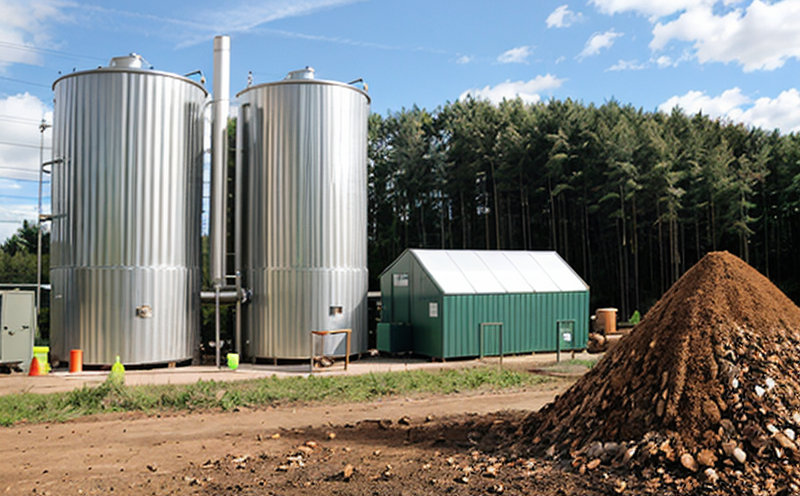ASTM E876 Nitrogen Content in Biomass Fuels
The ASTM E876 standard provides a definitive method for determining the total nitrogen content of biomass fuels. This is crucial as nitrogen content can significantly impact the efficiency, emissions, and overall performance of waste-to-energy conversion processes. Understanding and accurately measuring nitrogen content helps in optimizing fuel quality and ensuring compliance with emission regulations.
Biomass fuels derived from various sources like wood residues, agricultural byproducts, or municipal solid waste contain a mix of organic compounds that can be complex and variable. The presence of nitrogen in biomass fuels is not just limited to protein but also includes other forms such as ammonia, urea, and amino acids. This variability makes it essential to use precise analytical techniques.
The ASTM E876 method involves the combustion of a known mass of the sample in an oxygen-rich environment at elevated temperatures (typically around 950°C). The evolved gases are then passed through a series of absorbents that capture and measure the nitrogen content. This process allows for accurate quantification of total nitrogen, which is key to understanding the fuel's calorific value and its potential impact on combustion processes.
Given the diverse nature of biomass fuels, the ASTM E876 method provides a standardized approach to ensure consistency across different samples and laboratories. This standardization is vital in sectors such as waste management and recycling where precision and reliability are paramount. Compliance with this standard ensures that stakeholders can make informed decisions regarding fuel quality and process optimization.
The following table outlines the key aspects of ASTM E876:
| Aspect | Description |
|---|---|
| Sample Preparation | Biomass samples are dried at 105°C ± 2°C until constant weight, then weighed accurately. |
| Combustion Conditions | Combustion occurs in a nitrogen-free environment to ensure accurate measurement of evolved gases. |
| Analytical Equipment | A gas chromatograph or similar apparatus is used for detecting and quantifying the nitrogen content. |
| Data Interpretation | The results are reported as mass percentage of total nitrogen in the sample. |
Understanding the role of nitrogen in biomass fuels is critical for optimizing waste-to-energy processes. By accurately measuring nitrogen, stakeholders can enhance fuel quality, improve combustion efficiency, and reduce emissions. This method also supports compliance with international standards such as ISO 17826:2019.
Applied Standards
| Standard | Description |
|---|---|
| ASTM E876-19a | American Society for Testing and Materials standard method for determining the total nitrogen content of biomass fuels. |
| ISO 17826:2019 | International Organization for Standardization standard that sets guidelines for testing methods in waste management. |
| EN ISO 5893-1:2014 | European standard for the chemical analysis of biomass fuels, including nitrogen content. |
| IEC 62386 | International Electrotechnical Commission standard relevant to energy systems and networks involving biomass. |
The ASTM E876-19a method is widely recognized for its accuracy and reliability in determining the nitrogen content of biomass fuels. Compliance with this standard ensures consistency across different laboratories, which is crucial for reliable data and robust decision-making processes.
Other international standards such as ISO 17826:2019 provide additional context on waste management practices, while EN ISO 5893-1:2014 focuses specifically on the chemical analysis of biomass fuels. The IEC 62386 standard is particularly relevant for those involved in energy systems and networks involving biomass.
Benefits
- Increased efficiency of waste-to-energy conversion processes
- Precise quantification leading to better fuel quality assurance
- Enhanced compliance with environmental regulations
- Improved combustion performance and reduced emissions
- Data-driven decision-making for R&D purposes
- Supporting accurate procurement decisions
- Facilitating the development of new biomass-based products
The precise measurement of nitrogen content in biomass fuels through ASTM E876 is essential for optimizing waste-to-energy processes. By ensuring that fuel quality meets rigorous standards, stakeholders can achieve greater efficiency and reduce environmental impact.
Use Cases and Application Examples
The ASTM E876 method is widely used in various sectors including waste management, recycling, and energy production. Here are some examples of its application:
- Waste-to-Energy Facilities: Ensuring that the nitrogen content aligns with optimal combustion parameters.
- Biomass Fuel Suppliers: Providing accurate reports on fuel quality to customers.
- R&D Departments: Investigating new biomass-based products and processes.
- Compliance Officers: Ensuring regulatory compliance through accurate testing.
The following table provides more specific examples of how ASTM E876 is applied in different scenarios:
| Sector | Description |
|---|---|
| Waste Management | Testing nitrogen content to ensure efficient waste-to-energy conversion. |
| Biomass Recycling | Determining the quality of biomass feedstock before processing. |
| Energy Production | Optimizing combustion parameters for maximum efficiency. |
| R&D | Investigating new products and processes involving biomass fuels. |
The ASTM E876 method is also crucial in supporting the development of new biomass-based products. By accurately measuring nitrogen content, stakeholders can ensure that these products meet quality standards and are suitable for various applications.





